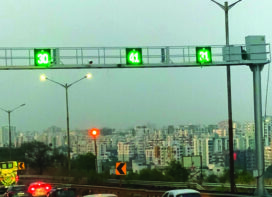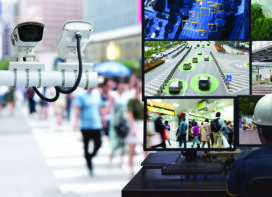 Road journey on developed cities like Mumbai and Delhi in India should not have been very different from that of a journey between Chicago and Houston in the USA. But the fact is, it is. While the former would require a traveller to spend about 35 hours, the latter would be completed in just 22 hours. And here is the catch – the American cities are separated by more than double the distance between the Indian metros. Trucks on Indian highways move at an average speed of about 25-40km/hr whereas the global average speed on highways is around 60-70km/hr.
Road journey on developed cities like Mumbai and Delhi in India should not have been very different from that of a journey between Chicago and Houston in the USA. But the fact is, it is. While the former would require a traveller to spend about 35 hours, the latter would be completed in just 22 hours. And here is the catch – the American cities are separated by more than double the distance between the Indian metros. Trucks on Indian highways move at an average speed of about 25-40km/hr whereas the global average speed on highways is around 60-70km/hr.
Now this is disappointing, specially since India boasts of the second largest road network in the world. However, only 60% of India’s road length is surfaced, and only 60% of the villages have access to all-weather roads. While 85% of passenger traffic uses roads as the main mode, 65% of freight too is dependent on it. So, a deficient road network impacts the country’s economy adversely. A recent Planning Commission study estimates that losses from traffic congestion and poor roads alone are as high as `300 billion.
The exceptional growth and reduction in the poverty of China has been attributed to the expansion of expressway network and the quality feeder roads connecting rural areas to highways/expressways. To sustain the present rate of economic growth, India needs to learn from its biggest competitor and ensure seamless growth of its road sector. Substantial investments on road development projects have been planned in the Eleventh and Twelfth five year plans with the Ministry of Road Transport announcing its intentions to build 20km of roads on a daily basis. The participation of the Private Sector is the key to meeting this objective. However, the actual private investment in the road sector falls short of the targets. According to the Mid–Term Appraisal (MTA) by the Planning Commission, just 16% of road project investments have come from the private sector. A major deterrent to private investment in roads is that revenue leakages in toll collections on Indian roads are very high. Road tolling is the only direct means of recovering costs for road agencies/developers. According to estimates, the government is losing over `15 billion annually due to leakages in toll collections.
Why can’t revenue leakages be stopped?
 Clearly, toll collections in India are fraught with multiple challenges. These issues range along the continuum from being purely systemic to being operational. Firstly, the lack of a standardised methodology or a central/state level agency which projects long term revenues based on estimation of uncontrollable factors such as GDP growth rates, interest rate movements, etc. leads to inconsistent revenue projections. Even traffic estimation does not form a part of the Model Concession Agreement and bidders are left to carry out estimations on their own, leading to inconsistent revenue projections. Secondly, registration data of Motor Vehicles is not electronically stored across states in India and hence, sharing them between the states becomes difficult. If a vehicle registered in one State defaults in another, it is almost impossible to bring defaulters to book owing to this bottleneck. Thirdly, unlike developed and other emerging markets, no uniform Electronic Toll Collection (ETC) system has been adopted nationwide by the toll operators in India. Further, customers are not incentivised for using smart cards/ tags. A card / tag of one operating system is not recognised by another toll operating system. This has resulted in the issue of interoperability between different cards/ tags of toll operators.
Clearly, toll collections in India are fraught with multiple challenges. These issues range along the continuum from being purely systemic to being operational. Firstly, the lack of a standardised methodology or a central/state level agency which projects long term revenues based on estimation of uncontrollable factors such as GDP growth rates, interest rate movements, etc. leads to inconsistent revenue projections. Even traffic estimation does not form a part of the Model Concession Agreement and bidders are left to carry out estimations on their own, leading to inconsistent revenue projections. Secondly, registration data of Motor Vehicles is not electronically stored across states in India and hence, sharing them between the states becomes difficult. If a vehicle registered in one State defaults in another, it is almost impossible to bring defaulters to book owing to this bottleneck. Thirdly, unlike developed and other emerging markets, no uniform Electronic Toll Collection (ETC) system has been adopted nationwide by the toll operators in India. Further, customers are not incentivised for using smart cards/ tags. A card / tag of one operating system is not recognised by another toll operating system. This has resulted in the issue of interoperability between different cards/ tags of toll operators.
Hence, the usage of ETC systems is limited and payments are made in cash making them more susceptible to thefts and embezzlement. Another point is that there are ambiguities within the Model Concession Agreement (MCA) on adoption of the ETC systems at toll plazas when awarding road projects. Apart from these pressing issues, the lack of a uniform system for classification of vehicles, lack of toll management skills, ineffective IT systems and weak security measures are some of the other key issues around revenue leakages in toll collections. To add to these woes, most of the Indian road developers do not use toll management tools such as automatic boom barrier and overhead light signals.
Unlike developed and other emerging markets, no uniform Electronic Toll Collection (ETC) system has been adopted nationwide by the toll operators in India.
What can be done?
A study commissioned by the Ministry of Road Transport and Highways in 2009 concluded that over the next four years roads brought under the operate, maintain and toll system for private investors would rise to a total of 35,000km, resulting in toll collection from national highways touching 10,000 crore, a five-fold increase. Making toll management a successful proposition in India would require integration of factors like proper planning, efficient mobilisation of funds, correct revenue projections, holistic risk analyses, technological integration, enhancements to the regulatory framework and a certain level of information sharing between the various authorities involved.
 TrafficInfraTech Magazine Linking People Places & Progress
TrafficInfraTech Magazine Linking People Places & Progress


